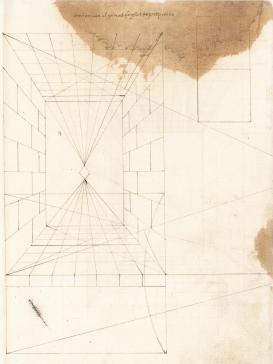Hernán Ruiz II, master mason of Seville cathedral and a key figure in the introduction of the Renaissance in Spain, left to posterity an architectural manuscript known as Libro de Arquitectura. In typical workshop fashion, the notebook includes geometrical and stonecutting diagrams, architectural drawings, the translation of Vitruvius' first book, and a number of schemes meant to illustrate some peculiar perspective rules based on visual angles or, to be precise, the chords that subtend these angles.
This Working Group project chapter analyzed the perspectival techniques used by Hernán Ruiz and discussed the possible sources of these methods. Firstly, although Ruiz includes in his manuscript a translation of Vitruvius, it is quite clear that he misunderstands the well-known paragraph about iconography, orthography, and scenography and that Vitruvius is not his primary source concerning perspective. Secondly, Ruiz may have used as sources the well-known drawings of columns with uneven divisions by Durer and Serlio that have been posited as evidence for "angular perspective." However, in fact he reversed Serlio’s and Durer’s methods: instead of using different heights that display the same angle to the eye, Hernán Ruiz was trying to compute the uneven angles subtended by a number of evenly-spaced tiles.
Other sources of these methods may be found in Hernán Ruiz’s expertise in stonecutting and the cartography of the period. In fact, Hernán Ruiz used similar techniques in order to construct templates for groin vaults; besides, maybe he had some knowledge of the geometrical methods used by the mapmakers at Casa de Contratación, that period’s main cartographic center for Spanish America. This is not least because Ruiz had drawn a plan for the building that housed this institution and possibly carried out some construction work here as well.

